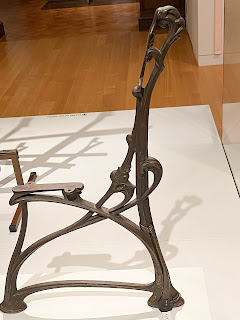Have a great Memorial Day … as soon as you have finished this Missive!
In New York we went to see an exhibition at the Cooper Hewitt: Smithsonian Design Museum. It was aptly named, “Hector Guimard: How Paris got its Curves”. It was organized by the Cooper Hewitt and the Richard H. Driehaus Museum in Chicago. In situ, or from the movies, or in an illustration for a book there is a good chance that you have seen an image to one of the old Paris Metro (subway) stations. Hector Guimard (1867-1942), received the contract in 1898 to design the entrance to the Paris underground which was developed in anticipation of the Paris Exposition of 1900. Guimard effectively introduced the art nouveau style into popular culture.
His design for the Metro was created in cast iron which I am sure was appealing in it being inexpensive for a mass transit system. The exhibition could obviously only show a photograph but you can still see some in Paris today.
Other designs in Iron are also shown such as a bracket for a bench. How often do you actually think about who designed the two sides of a park bench you may be sitting on, but when you do look you might see a pleasing and original design.
 |
| Richard H. Driehaus Collection |
Guimard built the Hôtel Guimard (1909-1912) for himself and his new wife Adeline (1909) at 122 Avenue Mozart, in the fashionable 16th arrondissement. It had an architectural studio for himself and a studio for his wife, a water colorist. Her father, Edward Oppenheim was a member of a major German Banking family, so Adeline was able to be her husband’s benefactor as well.
The show exhibits many of the media that Guimard designed for. One that I found most unusual was a wall panel that looked like leather but was actually made from linoleum. It was created for the Castel Béranger (1896-98) which is also in the 16th arrondissement. It was Guimard’s first solo project and an important transitional work for his career. An inscription on the façade reveals that the building won the coveted prize for Paris’ most beautiful façade in a contest held in 1898 by the City of Paris.
 |
| Credit: Musée d’Orsay |
I love Guimard’s furniture designs though we never had a piece by the artist in our own collection of art nouveau. Here, however, is an object that I do not think I would have wished to acquire. It is a side-chair (1900-1903) with a frame but lacking a back support. We can be sure it is a Guimard design because the drawing is shown beside it.
 |
| Credit: Lent by the Richard H. Driehaus |
 |
| Credit: Musée d’Orsay, Paris |
Between 1900 and 1901 Guimard produced three designs for the French porcelain factory at Sèvres. Only five of the largest model were made and the Metropolitan Museum lent their example known as the Binelles Vase (1903).
We gave our collection of Art Nouveau pewter to the Cooper Hewitt before moving to Santa Fe because the style did not fit in our newly adopted part of the country. However, one of the smallest pieces in the show I would make an exception for. It is a doorbell that would not be out of place on our front door.
After Guimard died, Adeline moved back to New York and worked on preserving her husband’s legacy. She donated works of art as well her husband’s drawings and papers to a number of different institutions. In the exhibition is the embroidered silk collar from the White Satin Coat her husband designed for their wedding day. Adeline donated it to the Cooper Hewitt in 1949.
 |
| Photo Credit: Matt Flynn |
As I wrote this Missive, I realized that I miss our art nouveau collection though we did save 3 objects for our current home.












No comments:
Post a Comment